Abstract
Spatiotemporally resolved data on photovoltaic (PV) power generation are very helpful to analyze the multiple impacts of this variable renewable energy on regional and local scales. In the absence of such disaggregated data for Germany, numerical simulations are needed to obtain the electricity production from PV systems for a time period and region under study. This manuscript presents how a physical simulation model, which uses open access weather and plant data as input vectors, can be created. The developed PV model is then applied to an ensemble of approximately 1.95 million PV systems, consisting of ground-mounted and rooftop installations, in order to compute their electricity production in Germany for the year 2020. The resulting spatially aggregated time series closely matches the measured PV feed-in pattern of Germany throughout the simulated year. Such disaggregated data can be applied to investigate the German PV power generation landscape at various spatiotemporal levels, as each PV system is taken into account with its technical data and the weather conditions at its geo-location. Furthermore, the German PV power generation landscape is presented as detailed maps based on these simulation results, which can also be useful for many other scientific fields such as energy system modeling.
1. Introduction
Many of the world’s leading countries have already started large-scale production of electricity from renewable energy sources, primarily wind and solar energy, to achieve the Paris Agreement goal of net-zero emissions by the middle of this century for mitigating climate change. Photovoltaics play a key role in this transition and are expected to become the world’s most important source of electricity production before 2050 [1]. According to the study in [1], the technological development set in motion by existing policies could lead to a global, irreversible tipping point at which photovoltaics will gradually dominate global electricity markets without the need for further climate policy measures. Otherwise, there are also uncertainties that could hinder this process, such as insufficient grid stability in renewables-dominated power grids or the limited capacity of future supply chains. To avoid such uncertainties and to find an optimal method for sustainable transformation of the power sector, further research is needed, which also requires disaggregated power generation data for existing PV systems, as presented in this study.
Worldwide, 189 GW of new PV capacity was erected in the year 2022, bringing the total capacity to 1055 GW [2]. In the German region, the installed PV capacity grew from 18 GW in 2010, to more than 82 GW by the end of 2023 [3,4], boosted by the abolition of the German PV cap of 52 GW in June 2020 and the steady decrease of the levelized cost of electricity for photovoltaics. This strong growth in photovoltaics will not only have a considerable influence on the development of future PV systems, including new concepts such as agrivoltaics and floating photovoltaics, but also on the necessary power grid transformation in a future more circular and electrified economy [5,6]. However, the lack of disaggregated power generation data of PV systems, mainly due to strict German data privacy laws, makes it difficult to comprehensively study the multiple impacts of increasing photovoltaics on regional and local scales.
Today’s studies on photovoltaics and renewable energies often use electricity production data from PV systems with high spatial, but only low temporal, resolutions, such as in many different analyses of the German power sector [7,8]. Meanwhile, there are also energy studies that already consider the power generation from PV systems with a high spatiotemporal resolution [9,10], but work with older data, from the year 2016 and earlier. As mentioned above, photovoltaics have experienced significant growth over the last years, both worldwide and in Germany. Consequently, updating disaggregated electricity production data, e.g., using the PV model introduced in this manuscript, becomes increasingly relevant for future research. This simulation model, which is an extended version of our preceding PV model described in [11], is part of the Renewable Spatial-Temporal Electricity Production (ReSTEP) model collection, which also contains biomass power, run-of-river hydropower, and wind power models [12,13].
This study shows a clear modeling approach that uses open access weather and plant data as input vectors to generate disaggregated electricity production data of PV systems. The rest of this manuscript is arranged in the following order: Section 2 introduces the input vectors as well as the data for calibration and verification of the PV model. The design of the simulation model with its main program steps using the PVGIS web application [14], which is also open access, is described in Section 3. In Section 4, this PV model is applied to an ensemble of about 1.95 million PV systems, consisting of ground-mounted and rooftop installations, to compute their electricity production in Germany for the year 2020. Then, the resulting time series are aggregated and compared with the measured total PV feed-in of Germany to verify the simulations. In addition, the German PV power generation landscape using these simulation results is shown as monthly resolved maps at the municipal level. This energy landscape is moreover analyzed at the federal state level. Finally, the study concludes with a brief discussion of the PV model presented and the simulation results obtained in Section 5.
2. Data
2.1. Weather Data
Highly resolved weather data, especially for the solar irradiance, are an essential precondition for detailed and accurate simulations of PV power generation, and the quality of these data is crucial for obtaining realistic results [15]. For the Central European or German region, various weather products with different spatial and temporal resolutions are freely available via the web interfaces of many meteorological institutions around the world. On the one hand, there are reanalysis weather data, such as the global MERRA/MERRA-2 and ERA-5 products with horizontal resolutions of a few tens of km [16,17,18], which have become a popular source for wind power studies in recent years [19,20]. On the other hand, satellite-based weather data often provide higher spatial resolutions, especially for solar radiation data, and are therefore mostly used for studies on solar resources or PV power generation [9,10,21].
Since reanalysis solar radiation data generally have larger uncertainties than satellite-based data, our study utilizes satellite-based weather data from the CM SAF collaboration [22] via the PVGIS web application. The used weather product PVGIS-SARAH2, which is derived from the second version of the SARAH solar radiation data from CM SAF, has an hourly time resolution and a horizontal resolution of 5 km for the German region [23]. Because of this high spatial resolution and the retrieval of the PVGIS time series for each required PV system location, no interpolation routines are needed in our simulation model. This circumstance reduces possible uncertainties due to additional interpolations and the runtime of the numerical simulations. Furthermore, solar radiation data from satellite images need to be verified with ground-based solar radiation measurements to assess the deviations of the satellite-based data. For the German region, the hourly values of the horizontal solar irradiance from PVGIS-SARAH2 were compared with measured data from the ground station in Lindenberg (Germany) and showed a high agreement with small mean deviations, according to the validation presented in [14].
The hourly resolved time series received via the PVGIS web application for a required time period and geo-location comprises the following information: date and time in UTC, PV system power, solar irradiance on inclined plane, sun height, air temperature at 2 m, and wind speed at 10 m from the ground. To retrieve these data from PVGIS, the location of the PV system with latitude and longitude, the rated power of the plant, the tilt (slope) and azimuth angles of the PV modules, the time period, and the weather product have to be specified for the web query.
The PVGIS version 5.2 and the weather product PVGIS-SARAH2 were used for all simulations presented in this manuscript. Figure 1 shows an excerpt of an hourly resolved time series for the year 2020 and a certain geo-location delivered by PVGIS 5.2 using its API. A detailed description of this API for hourly radiation data with all its features can be found in [24].
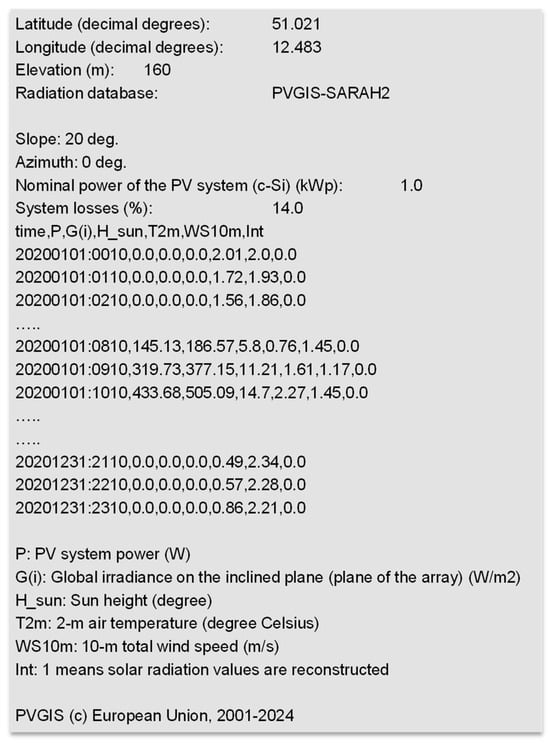
Figure 1.
Excerpt of an hourly resolved time series delivered by PVGIS 5.2 using its API for hourly radiation data.
2.2. Plant Data
The numerical simulations with the introduced PV model also require detailed plant data from the PV systems under investigation. These PV datasets consist of the location in geographic coordinates, specific technical information, and the (de-)commissioning date of the PV systems, as shown in Table 1.

Table 1.
Content of the PV datasets used for the PV model.
The plant data are based on open access information from the Core Energy Market Data Register provided by the Bundesnetzagentur [25], which can be downloaded via the online portal of the register [26], which also contains more information on the register and the freely available data. After filtering and cross-checking the raw data for the required time period, the compiled dataset comprises approximately 1.95 million PV systems for the year 2020. This plant dataset consists of ground-mounted and rooftop installations, with most of these PV systems receiving guaranteed power feed-in tariffs under the EEG. The total installed capacity of the dataset reaches 50 GW, which is less than the value of 54 GW reported by official sources [3,4], but also shows that most of the PV systems are covered by the used plant dataset.
2.3. Calibration Data
Specific calibration data are needed to make the numerical simulations realistic. In the absence of some of the required technical data for most PV systems, especially for the many small rooftop installations, appropriate average values must be found. For instance, the used module technology and the amount of system loss have to be assumed in order to calculate the PV system power. The system loss of a PV system describes all losses that result in the actual power fed into the connected grid being less than the power generated or able to be generated by the solar cells. Various reasons contribute to this loss, such as losses in power inverters and electric cables as well as losses caused by dirt or sometimes snow on the PV modules. For the amount of this system loss, PVGIS recommends a total value of 14% [14], which is used for all simulations performed for this manuscript. The applied semiconductor in solar cells is also not publicly available for each PV system. To date, crystalline silicon is by far the most commonly used semiconductor in solar cell manufacturing [27]. Thus, crystalline silicon has been selected as module technology used for the numerical simulations. The azimuth and tilt angles of the PV modules are also needed for the PV model. The azimuth angle is set to a value of zero for all PV systems, which stands for an alignment of the solar cells to the south in PVGIS. For the tilt angle, a fixed value of 20° is assumed because ground-mounted systems are typically arranged with tilt angles in this range in order to reduce mutual shading of these PV modules, particularly in the wintertime when the maximum sun elevation only reaches low values [28]. In addition, it could be shown by preceding simulations that 20° is also an appropriate average value for rooftop installations in Germany [11].
2.4. Verification Data
In order to verify the PV model and assess its accuracy, the calculated results from numerical simulations need to be compared with measurements on real systems. However, it is not necessary to explicitly validate the irradiance-to-power calculation, because the PV system power from solar cells is determined by extensive PVGIS algorithms that have already been verified in numerous peer-reviewed publications [29,30]. Furthermore, the presented PV model is an extended version of our preceding simulation model, which has been thoroughly validated by detailed system power measurements on a technically known PV system in [11]. Since this extended model mainly covers the changes required for the PVGIS version 5.2 in order to use its features and the new weather products, it is not necessary to perform this part of the model validation again. Moreover, a comparative evaluation between PVGIS, PVWatts, and RETScreen in [30] has shown that PVGIS often delivers better results than the other two freely available tools for PV power generation when compared to measurements of existing PV parks. There are also many other software products, such as PVsyst and PV*SOL, that can simulate the electricity production of PV systems, but they are mainly intended for planning single PV systems or parks, and not for simulating large ensembles of existing PV systems. In addition, these products are not completely freeware and thus not suitable for our modeling approach, which is based on open access data and tools.
Nonetheless, the simulation model not only incorporates the PVGIS algorithms, but also takes into account, for instance, the time grid of the weather data and intra-annual plant changes to accurately calculate the power generation from each PV system. Therefore, the results obtained from the calibrated PV model showing the hourly and daily electricity production should be compared with measured PV feed-in data. In the absence of such information from PV systems in Germany, primarily caused by strict German privacy laws, it is not possible to verify the simulation results on regional and local scales. Otherwise, if the simulated power generation data of the PV systems are spatially aggregated across Germany, they can be verified with freely available total PV feed-in measurements of Germany for 2020 provided by the Bundesnetzagentur via its information platform SMARD [31].
3. Model
In general, electricity production data of variable renewable energies such as PV systems can be generated using either physical or statistical models [32,33]. Unlike statistical methods, the simulation results obtained from physical models are typically based on highly resolved weather data provided by meteorological institutions. Thus, an important asset of physical models is their capability to compute disaggregated power generation data with high spatial and temporal resolutions. Figure 2 shows the design of the PV model with its program steps, in which the weather and plant data are used as input vectors for the physical simulation model. The model calibration is done with the previously described calibration data before running the numerical simulations. The program steps of the calibrated PV model are visualized as light grey rectangles and the input and output data as yellow and orange containers, respectively. The arrows between these elements symbolize the flow of data.
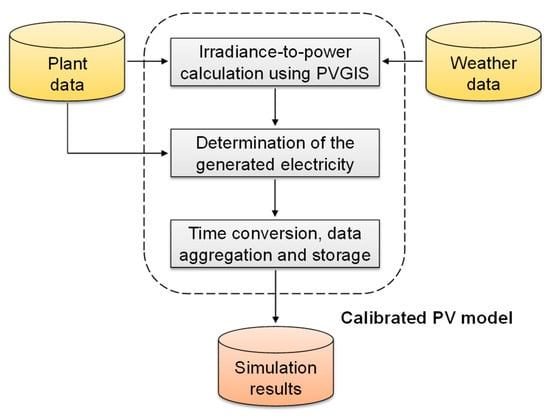
Figure 2.
Design of the calibrated PV model with its program steps and the input and output data.
The operation of the simulation model can be divided into three main program steps, as displayed in Figure 2, which are executed for the PV systems of the compiled plant dataset. First, the computation of the PV system power from the solar cells using extensive algorithms of PVGIS for the irradiance-to-power calculation [14]. Second, the determination of the electricity produced, taking into account the time grid of the weather data and the (de-)commissioning date for each PV system. In the third and final step, the resulting time series are converted to local time, spatially and temporally aggregated, and stored as CSV files for later data analysis and application.
Further explanations of the PV model and the incorporated PVGIS algorithms, e.g., the influence of shadows on PV modules from the surrounding terrain, can be found in [11,14,24]. Based on this model design and the data sources introduced in this study, it is readily possible to perform thorough simulations of the electricity production from PV systems using common open-source and object-oriented programming languages like R, C#, or Python.
4. Results
4.1. Simulation Results
The PV power generation in Germany for the year 2020 is simulated using the input vectors and the PV model presented in the previous Section 2 and Section 3. Because of the large number of approximately 1.95 million PV systems, consisting of ground-mounted and rooftop installations, they are grouped into their municipal areas for runtime optimization. For this purpose, the geographic center coordinates of each municipality are used for the simulations. Nonetheless, for each PV system, the rated power and the (de-)commissioning date are taken into account separately. Since for most PV systems, especially for the many small rooftop installations, no further technical information is available from official sources, appropriate average values are used for the model calibration.
After running the numerical simulations, the spatially resolved PV power generation data were aggregated into a single time series. This was done to be able to compare the simulation results with the measured total PV feed-in of Germany. The measured and simulated time series for 2020 in daily resolution are depicted in Figure 3.
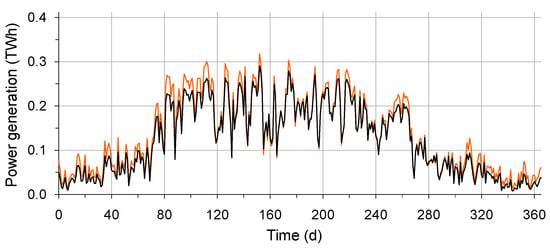
Figure 3.
Measured feed-in data (black line) and simulated power generation (orange line) from all PV systems in Germany for the year 2020.
The simulated PV power generation, shown as the orange line in this figure, closely matches the measured PV feed-in pattern of Germany throughout the year 2020. The deviations in Figure 3 are mainly the result of the following points:
- Feed-in interruptions due to PV system maintenance or capacity constraints in the connected power grid;
- Self-consumption of the generated power, especially in the case of smaller PV systems of private operators, which is then not fed into the grid;
- The uncertainties regarding the involved weather data, in particular the fact that these are hourly averages;
- Use of average values for model calibration in the absence of specific technical data for PV systems.
The frequent overestimation in the simulations is primarily due to the first two points, which cannot be taken into account by physical models that use weather and plant data as input vectors, such as the PV model presented. Nonetheless, with an MAE of 13.3 GWh and an RMSE of 16.3 GWh, considering the daily aggregated values, the simulated time series shows a very high agreement with the measured time series also from a statistical point of view. With regard to the total electricity production of 45.8 TWh from all PV systems in Germany for 2020 according to [31], the relative MAE and RMSE also reach low values of 0.03% and 0.04%, respectively. For further statistical analysis, an additional Pearson correlation between the first differences regarding the measured and simulated time series, as defined in [10,13], results in a high correlation coefficient of 0.99, showing that the trends of these time series are also largely in the same direction and order of magnitude. Although the aggregated results may also exhibit statistical smoothing, which is in contrast to physical smoothing effects [34], all analyses indicate that the simulations follow the measurements well.
In order to emphasize the benefits of satellite-based weather data for physical models such as our PV model, we additionally compared simulation results using the PVGIS-SARAH2 weather product with simulations using MERRA/MERRA-2 reanalysis data [17] via the renewables.ninja web application [9,35]. Both simulations used the same model calibration, which is also identical to the calibration data described in this manuscript. These numerical simulations were performed for a plant dataset of about 1.77 million PV systems in Germany for the year 2019, because the time-consuming simulations using MERRA/MERRA-2 weather data were carried out exclusively for this time period. Figure 4 displays the measured total PV feed-in and the aggregated PV power generation simulations for both weather products in daily resolution with arbitrary units (a.u.). In order to make it easier to compare the pattern of these time series visually, they are displayed at some distance from each other.
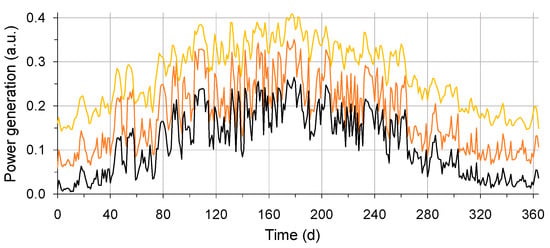
Figure 4.
Measured feed-in data (black line) and simulated power generation from all PV systems in Germany for the year 2019 using satellite-based (orange line) and reanalysis (yellow line) weather data.
The patterns in Figure 4 clearly demonstrate that the fine structure of the measured PV feed-in pattern is much better reproduced by the simulations with PVGIS-SARAH2 than with MERRA/MERRA-2 weather data, which is due to the use of satellite-based information for the solar irradiance and the higher horizontal resolution of the PVGIS-SARAH2 weather product. The simulation results with PVGIS-SARAH2 also have a much higher statistical agreement with the measured feed-in data with relative MAE and RMSE values of 0.04% and 0.05%, in contrast to the MERRA/MERRA-2 simulations with values of 0.07% and 0.09%, with regard to the total electricity production of 41.9 TWh from all PV systems in Germany for 2019 [31]. This is made even clearer by a Pearson correlation between the first differences with a high coefficient of 0.99 using PVGIS-SARAH2 compared to 0.38 using MERRA/MERRA-2 weather data.
4.2. Energy Landscape
Regional and local progress as well as untapped potential of photovoltaics can be better tracked using the spatiotemporally resolved distribution of their electricity production. Figure 5 shows the monthly power generation from PV systems at the municipal level based on the simulation results obtained in this study.
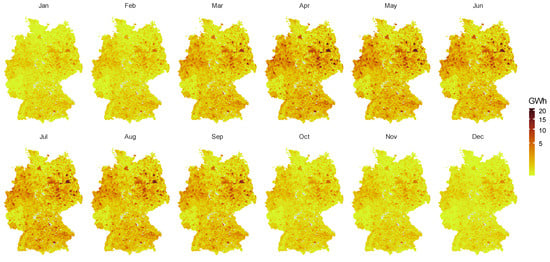
Figure 5.
Monthly power generation from PV systems at the municipal level in Germany for the year 2020, depicted in 50 shades of orange.
The maps clearly display that more electricity is produced in the southern and central parts of Germany, especially in many municipal areas of Bavaria, Saarland, North Rhine-Westphalia, Saxony-Anhalt, and Brandenburg, than in the far north of Germany, including the coastal regions. It can further be seen that a significant amount of electricity is produced in urban areas such as Berlin, Hamburg, and Munich. This is in contrast to wind power generation and is due to the high density of rooftop installations in these areas. Figure 5 also shows that more electricity is produced in the summer half of the year than in the winter months, which is typical for the power generation from PV systems in the German region. In addition to this analysis, Figure 6 displays the simulated PV power generation in daily resolution at the federal state level for three states in Germany as an example.
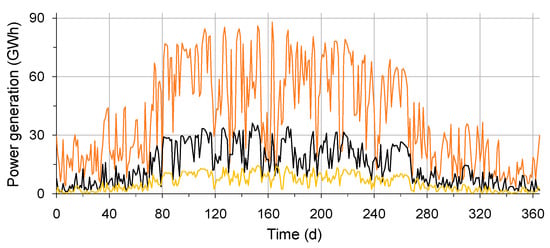
Figure 6.
Daily PV power generation in the states of Bavaria (orange line), North Rhine-Westphalia (black line), and Mecklenburg-Western Pomerania (yellow line) for the year 2020.
This figure also visualizes the regional differences, which are correspondingly smaller but still exist when the electricity production is related to the area of the federal state, as depicted in Figure 7. It is especially at this state level that many of Germany’s regulations and policy decisions are made, which have a considerable influence on the energy transition and its implementation speed. Figure 7 additionally shows the different patterns of the PV power generation, which are mainly caused by the different weather conditions in these states.
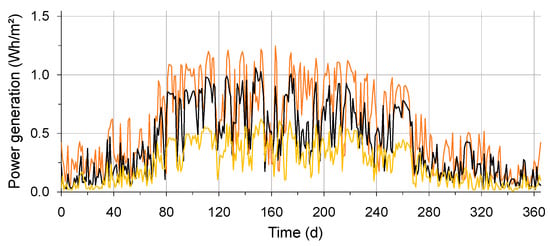
Figure 7.
Daily PV power generation in relation to the area of the federal state for Bavaria (orange line), North Rhine-Westphalia (black line), and Mecklenburg-Western Pomerania (yellow line) for the year 2020.
The simulation results generated with the presented PV model can therefore contribute to an improved assessment of the existing energy landscape in Germany at various spatiotemporal levels. This also allows a better categorization of the German region into different areas for tailored policy measures to accelerate the necessary energy system transformation, especially for areas where the share of photovoltaics is too low to meet the climate targets for Europe and Germany. Moreover, meaningful energy indicators, such as spatiotemporally resolved capacity factors or full load hours of PV systems, can be easily derived with the help of such disaggregated power generation data. As an example, Table 2 lists the annual capacity factor at the federal state level in Germany for 2020 according to the equation given in [10]. This table also includes the total electricity production in relation to the area of the federal state referred to in our study as regional energy density.

Table 2.
Capacity factor and energy density of PV systems at the federal state level for the year 2020.
Table 2 clearly shows that the federal states in the far south and southwest, such as Bavaria, Saarland, and Rhineland-Palatinate, reach values of about 12%, with a maximum capacity factor of 12.4% in Baden-Württemberg, which are primarily due to the many hours of sunshine in these regions for 2020. Otherwise, the states in northern Germany have capacity factors of around 11% and below, with the lowest value in Hamburg at 10.2%, which is typical for coastal regions with many cloudy and rainy days. In terms of regional energy density, the federal states in the far south and southwest, with the exception of Rhineland-Palatinate, also achieve the highest values, with a maximum energy density of 204 Wh/m2 in Bavaria.
5. Discussion
In addition to presenting our PV model, which utilizes publicly available information as input data, one of the main reasons for this manuscript was to update the disaggregated power generation data of PV systems in Germany to better assess the local and regional differences in photovoltaics. For this purpose, numerical simulations were performed for the year 2020, since the PVGIS-SARAH2 weather product was only available up to that time. It could be clearly demonstrated that the computed electricity production closely matches the measured PV feed-in pattern of Germany when using appropriate average values for the model calibration. In conclusion, very realistic simulation results can be achieved with this PV model in combination with the presented open access weather and plant data, even for a long time period and a large region under investigation.
Furthermore, this study has introduced a clear modeling approach to produce disaggregated power generation data of PV systems using open access data, allowing the interested community to create their own simulation models based on the model design and data sources shown in this manuscript. In addition, this PV model can be used without modification for other countries, provided that the necessary data on the PV systems are available for the country under study. Many other analyses, such as scenario-based simulations in the field of energy system modeling [36,37] or evaluation studies for PV systems [38,39,40], can profit from the high-resolution electricity production data generated by the PV model. Moreover, in combination with the wind power model from the ReSTEP model collection [12], which also uses the weather products via the PVGIS web application, a more comprehensive picture of the renewable energy landscape in Germany can be drawn.
Author Contributions
Conceptualization, R.L.; Methodology, R.L.; Software, R.L.; Validation, R.L.; Formal Analysis, R.L.; Investigation, R.L.; Resources, R.L.; Data Curation, R.L.; Writing—Original Draft Preparation, R.L.; Writing—Review and Editing, R.L.; Visualization, R.L.; Supervision, R.L. and D.T.; Project Administration, D.T.; All authors have read and agreed to the published version of the manuscript.
Funding
This research received general funding from the Helmholtz Association of German Research Centres.
Data Availability Statement
Data is contained within the article.
Acknowledgments
The authors thank David Manske (UFZ) for compiling the plant dataset and Nicole Honig-Lehneis for proofreading the manuscript.
Conflicts of Interest
Author Reinhold Lehneis was employed by the Department of Microbial Biotechnology, Helmholtz Centre for Environmental Research GmbH—UFZ and Department of Bioenergy, Helmholtz Centre for Environmental Research GmbH—UFZ. Author Daniela Thrän was employed by the Department of Bioenergy, Helmholtz Centre for Environmental Research GmbH—UFZ. The authors declare that the research was conducted in the absence of any commercial or financial relationships that could be construed as a potential conflict of interest.
References
- Nijsse, F.J.M.M.; Mercure, J.F.; Ameli, N.; Larosa, F.; Kothari, S.; Rickman, J.; Vercoulen, P.; Pollitt, H. The momentum of the solar energy transition. Nat. Commun. 2023, 14, 6542. [Google Scholar] [CrossRef] [PubMed]
- IRENA. Renewable Energy Statistics 2023; International Renewable Energy Agency (IRENA): Abu Dhabi, United Arab Emirates, 2023; Available online: https://www.irena.org/publications (accessed on 15 April 2024).
- Zeitreihen zur Entwicklung der Erneuerbaren Energien in Deutschland unter Verwendung von Daten der Arbeitsgruppe Erneuerbare Energien-Statistik (AGEE-Stat); Umweltbundesamt (UBA): Dessau-Roßlau, Germany, 2024; Available online: https://www.umweltbundesamt.de (accessed on 16 April 2024).
- Statistiken ausgewählter erneuerbarer Energieträger zur Stromerzeugung; Bundesnetzagentur für Elektrizität, Gas, Telekommunikation, Post und Eisenbahnen: Bonn, Germany, 2024; Available online: https://www.bundesnetzagentur.de (accessed on 16 April 2024).
- Harnisch, F.; Urban, C. Electrobiorefineries: Unlocking the Synergy of Electrochemical and Microbial Conversions. Angew. Chem. Int. Ed. 2018, 57, 10016–10023. [Google Scholar] [CrossRef]
- Harnisch, F.; Lehneis, R. The power grids need to be made ready for a circular and bio-based economy. Next Sustain. 2023, 2, 100010. [Google Scholar] [CrossRef]
- Rauner, S.; Eichhorn, M.; Thrän, D. The spatial dimension of the power system: Investigating hot spots of Smart Renewable Power Provision. Appl. Energy 2016, 184, 1038–1050. [Google Scholar] [CrossRef]
- Eising, M.; Hobbie, H.; Möst, D. Future wind and solar power market values in Germany—Evidence of spatial and technological dependencies? Energy Econ. 2020, 86, 104638. [Google Scholar] [CrossRef]
- Pfenninger, S.; Staffell, I. Long-term patterns of European PV output using 30 years of validated hourly reanalysis and satellite data. Energy 2016, 114, 1251–1265. [Google Scholar] [CrossRef]
- Lehneis, R.; Manske, D.; Schinkel, B.; Thrän, D. Spatiotemporal Modeling of the Electricity Production from Variable Renewable Energies in Germany. ISPRS Int. J. Geo-Inf. 2022, 11, 90. [Google Scholar] [CrossRef]
- Lehneis, R.; Manske, D.; Thrän, D. Generation of Spatiotemporally Resolved Power Production Data of PV Systems in Germany. ISPRS Int. J. Geo-Inf. 2020, 9, 621. [Google Scholar] [CrossRef]
- Lehneis, R.; Manske, D.; Thrän, D. Modeling of the German Wind Power Production with High Spatiotemporal Resolution. ISPRS Int. J. Geo-Inf. 2021, 10, 104. [Google Scholar] [CrossRef]
- Lehneis, R.; Thrän, D. Temporally and Spatially Resolved Simulation of the Wind Power Generation in Germany. Energies 2023, 16, 3239. [Google Scholar] [CrossRef]
- EU Science Hub–Photovoltaic Geographical Information System (PVGIS), European Commission’s Joint Research Centre (JRC), Brussels, Belgium. Available online: https://ec.europa.eu/jrc/en/pvgis (accessed on 15 March 2024).
- Amin, A.; Mourshed, M. Weather and climate data for energy applications. Renew. Sustain. Energy Rev. 2024, 192, 114247. [Google Scholar] [CrossRef]
- Rienecker, M.M.; Suarez, M.J.; Gelaro, R.; Todling, R.; Bacmeister, J.; Liu, E.; Bosilovich, M.G.; Schubert, S.D.; Takacs, L.; Kim, G.-K.; et al. MERRA: NASA’s Modern-Era Retrospective Analysis for Research and Applications. J. Clim. 2011, 24, 3624–3648. [Google Scholar] [CrossRef]
- Gelaro, R.; McCarty, W.; Suárez, M.J.; Todling, R.; Molod, A.; Takacs, L.; Randles, C.A.; Darmenov, A.; Bosilovich, M.G.; Reichle, R.; et al. The Modern-Era Retrospective Analysis for Research and Applications, Version 2 (MERRA-2). J. Clim. 2017, 30, 5419–5454. [Google Scholar] [CrossRef] [PubMed]
- Hersbach, H.; Bell, B.; Berrisford, P.; Hirahara, S.; Horányi, A.; Muñoz-Sabater, J.; Nicolas, J.; Peubey, C.; Radu, R.; Schepers, D.; et al. The ERA5 global reanalysis. Q. J. R. Meteorol. Soc. 2020, 146, 1999–2049. [Google Scholar] [CrossRef]
- Olauson, J.; Bergkvist, M. Modelling the Swedish wind power production using MERRA reanalysis data. Renew. Energy 2015, 76, 717–725. [Google Scholar] [CrossRef]
- Gruber, K.; Regner, P.; Wehrle, S.; Zeyringer, M.; Schmidt, J. Towards global validation of wind power simulations: A multicountry assessment of wind power simulation from MERRA-2 and ERA-5 reanalyses bias-corrected with the global wind atlas. Energy 2022, 238, 121520. [Google Scholar] [CrossRef]
- Behr, H.D.; Jung, C.; Trentmann, J.; Schindler, D. Using satellite data for assessing spatiotemporal variability and complementarity of solar resources—A case study from Germany. Meteorol. Z. 2021, 30, 515–532. [Google Scholar] [CrossRef]
- Satellite Application Facility on Climate Monitoring (CM SAF), Deutscher Wetterdienst, Offenbach, Germany. Available online: https://www.cmsaf.eu (accessed on 15 March 2024).
- Gracia Amillo, A.M.; Taylor, N.; Martinez, A.M.; Dunlop, E.D.; Mavrogiorgios, P.; Fahl, F.; Arcaro, G.; Pinedo, I. Adapting PVGIS to Trends in Climate, Technology and User Needs. In Proceedings of the 38th European Photovoltaic Solar Energy Conference and Exhibition (PVSEC) 2021, Online, 6–10 September 2021; pp. 907–911. [Google Scholar] [CrossRef]
- EU Science Hub–API Support Page for PVGIS, European Commission’s Joint Research Centre (JRC), Brussels, Belgium. Available online: https://joint-research-centre.ec.europa.eu/photovoltaic-geographical-information-system-pvgis/getting-started-pvgis/api-non-interactive-service_en (accessed on 15 March 2024).
- Core Energy Market Data Register, Bundesnetzagentur für Elektrizität, Gas, Telekommunikation, Post und Eisenbahnen, Bonn, Germany. Available online: https://www.bundesnetzagentur.de/EN/Areas/Energy/CoreEnergyMarketDataRegister/start.html (accessed on 26 March 2024).
- Online Portal of the Core Energy Market Data Register, Bundesnetzagentur für Elektrizität, Gas, Telekommunikation, Post und Eisenbahnen, Bonn, Germany. Available online: https://www.marktstammdatenregister.de/MaStR (accessed on 26 March 2024).
- Hosenuzzaman, M.; Rahim, N.A.; Selvaraj, J.; Hasanuzzaman, M.; Malek, A.B.M.A.; Nahar, A. Global prospects, progress, policies, and environmental impact of solar photovoltaic power generation. Renew. Sustain. Energy Rev. 2015, 41, 284–297. [Google Scholar] [CrossRef]
- Krömke, F. Ertragsgutachten–PV Freiflächenanlage BEMA Halde Korbwerder, Sachsen-Anhalt, Deutschland; Berlin, Germany, 2016. Available online: https://www.helionat.de (accessed on 31 August 2020).
- Šúri, M.; Huld, T.A.; Dunlop, E.D.; Ossenbrink, H.A. Potential of solar electricity generation in the European Union member states and candidate countries. Sol. Energy 2007, 81, 1295–1305. [Google Scholar] [CrossRef]
- Psomopoulos, C.S.; Ioannidis, G.C.; Kaminaris, S.D.; Mardikis, K.D.; Katsikas, N.G. A Comparative Evaluation of Photovoltaic Electricity Production Assessment Software (PVGIS, PVWatts and RETScreen). Environ. Process. 2015, 2, 175–189. [Google Scholar] [CrossRef]
- SMARD–Strommarktdaten, Stromhandel und Stromerzeugung in Deutschland 2020, Bundesnetzagentur für Elektrizität, Gas, Telekommunikation, Post und Eisenbahnen, Bonn, Germany. Available online: https://www.smard.de/home (accessed on 19 January 2022).
- Brecl, K.; Topič, M. Photovoltaics (PV) System Energy Forecast on the Basis of the Local Weather Forecast: Problems, Uncertainties and Solutions. Energies 2018, 11, 1143. [Google Scholar] [CrossRef]
- Benth, F.E.; Ibrahim, N.A. Stochastic modeling of photovoltaic power generation and electricity prices. J. Energy Mark. 2017, 10, 1–33. [Google Scholar] [CrossRef]
- Lehneis, R.; Jauregui, C.; Steinmetz, A.; Limpert, J.; Tünnermann, A. Smoothed spectra for enhanced dispersion-free pulse duration reduction of passively Q-switched microchip lasers. Opt. Lett. 2014, 39, 505–508. [Google Scholar] [CrossRef] [PubMed]
- Pfenninger, S.; Staffell, I. Renewables.ninja. Available online: https://www.renewables.ninja (accessed on 2 May 2022).
- Esmaeili Aliabadi, D.; Manske, D.; Seeger, L.; Lehneis, R.; Thrän, D. Integrating Knowledge Acquisition, Visualization, and Dissemination in Energy System Models: BENOPTex Study. Energies 2023, 16, 5113. [Google Scholar] [CrossRef]
- Millinger, M.; Tafarte, P.; Jordan, M.; Hahn, A.; Meisel, K.; Thrän, D. Electrofuels from excess renewable electricity at high variable renewable shares: Cost, greenhouse gas abatement, carbon use and competition. Sustain. Energy Fuels 2021, 5, 828–843. [Google Scholar] [CrossRef]
- Guaita-Pradas, I.; Marques-Perez, I.; Gallego, A.; Segura, B. Analyzing territory for the sustainable development of solar photovoltaic power using GIS databases. Environ. Monit. Assess. 2019, 191, 764. [Google Scholar] [CrossRef] [PubMed]
- Tarigan, E. Comparison of Energy Production Between Fixed-Mount and Tracking Systems of Solar PV Systems in Jakarta, Indonesia. Future Cities Environ. 2023, 9, 3. [Google Scholar] [CrossRef]
- Mainzer, K.; Fath, K.; McKenna, R.; Stengel, J.; Fichtner, W.; Schultmann, F. A high-resolution determination of the technical potential for residential-roof-mounted photovoltaic systems in Germany. Sol. Energy 2014, 105, 715–731. [Google Scholar] [CrossRef]
Disclaimer/Publisher’s Note: The statements, opinions and data contained in all publications are solely those of the individual author(s) and contributor(s) and not of MDPI and/or the editor(s). MDPI and/or the editor(s) disclaim responsibility for any injury to people or property resulting from any ideas, methods, instructions or products referred to in the content. |
© 2024 by the authors. Licensee MDPI, Basel, Switzerland. This article is an open access article distributed under the terms and conditions of the Creative Commons Attribution (CC BY) license (https://creativecommons.org/licenses/by/4.0/).